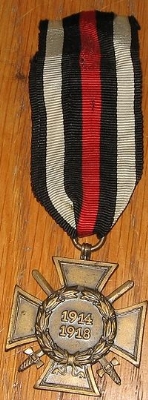
Cross of Honor
Encyclopedia
The Cross of Honor, also known as the Honor Cross or, popularly, the Hindenburg Cross, was a commemorative medal inaugurated on July 13, 1934 by Reichspräsident
Paul von Hindenburg
for those soldiers of Imperial Germany
who fought in World War I
. It came in three versions:
After the annexation (Anschluss
) of Austria in 1938, Austrian veterans of World War I
were also eligible for the Cross of Honor.
A total of 6,250,000 Crosses were awarded to combatants, 1,200,000 were awarded to non-combatants and 720,000 medals were awarded to next-of-kin.
(although smaller in size), in the center of the obverse are the dates of the First World War (1914–1918) surrounded with a wreath of oak leaves, the reverse of the medal in plain. A variation with an anchor in the center, and referred to as the Naval Cross, was issued to veterans of the Imperial German Navy.
The Honor Cross for War Participants differed from the Honor Cross for Combatants by not having the crossed swords. The Honor Cross for Next-of-Kin also lacked swords, was lacquered in black, and had a different ribbon.
The medal is suspended from a ribbon with a thin black lines of its sides, a red line in the center and next to it a black and white lines on each side, on the next-of-kin medal the ribbon colors are reverse.
Reichspräsident
The Reichspräsident was the German head of state under the Weimar constitution, which was officially in force from 1919 to 1945. In English he was usually simply referred to as the President of Germany...
Paul von Hindenburg
Paul von Hindenburg
Paul Ludwig Hans Anton von Beneckendorff und von Hindenburg , known universally as Paul von Hindenburg was a Prussian-German field marshal, statesman, and politician, and served as the second President of Germany from 1925 to 1934....
for those soldiers of Imperial Germany
German Empire
The German Empire refers to Germany during the "Second Reich" period from the unification of Germany and proclamation of Wilhelm I as German Emperor on 18 January 1871, to 1918, when it became a federal republic after defeat in World War I and the abdication of the Emperor, Wilhelm II.The German...
who fought in World War I
World War I
World War I , which was predominantly called the World War or the Great War from its occurrence until 1939, and the First World War or World War I thereafter, was a major war centred in Europe that began on 28 July 1914 and lasted until 11 November 1918...
. It came in three versions:
- Honor Cross for CombatantsHonour Cross for CombatantsThe Honour Cross for Combatants was one of three versions of the Cross of Honor to be awarded.- Recipients :* Walther von Brauchitsch* Wilhelm Keitel* Günther von Kluge* Erwin Rommel* Albert Kesselring* Erwin von Witzleben* Erich von Manstein...
(Ehrenkreuz für Frontkämpfer) – for soldiers who fought on the front. - Honor Cross for War Participants (Ehrenkreuz für Kriegsteilnehmer) – for non-combatant soldiers
- Honor Cross for Next-of-Kin (Ehrenkreuz für Hinterbliebene) – for the next-of-kin of fallen soldiers
After the annexation (Anschluss
Anschluss
The Anschluss , also known as the ', was the occupation and annexation of Austria into Nazi Germany in 1938....
) of Austria in 1938, Austrian veterans of World War I
World War I
World War I , which was predominantly called the World War or the Great War from its occurrence until 1939, and the First World War or World War I thereafter, was a major war centred in Europe that began on 28 July 1914 and lasted until 11 November 1918...
were also eligible for the Cross of Honor.
A total of 6,250,000 Crosses were awarded to combatants, 1,200,000 were awarded to non-combatants and 720,000 medals were awarded to next-of-kin.
Design
The medal was designed by Eugene Godet, its shape is similar to the Iron CrossIron Cross
The Iron Cross is a cross symbol typically in black with a white or silver outline that originated after 1219 when the Kingdom of Jerusalem granted the Teutonic Order the right to combine the Teutonic Black Cross placed above a silver Cross of Jerusalem....
(although smaller in size), in the center of the obverse are the dates of the First World War (1914–1918) surrounded with a wreath of oak leaves, the reverse of the medal in plain. A variation with an anchor in the center, and referred to as the Naval Cross, was issued to veterans of the Imperial German Navy.
The Honor Cross for War Participants differed from the Honor Cross for Combatants by not having the crossed swords. The Honor Cross for Next-of-Kin also lacked swords, was lacquered in black, and had a different ribbon.
The medal is suspended from a ribbon with a thin black lines of its sides, a red line in the center and next to it a black and white lines on each side, on the next-of-kin medal the ribbon colors are reverse.

